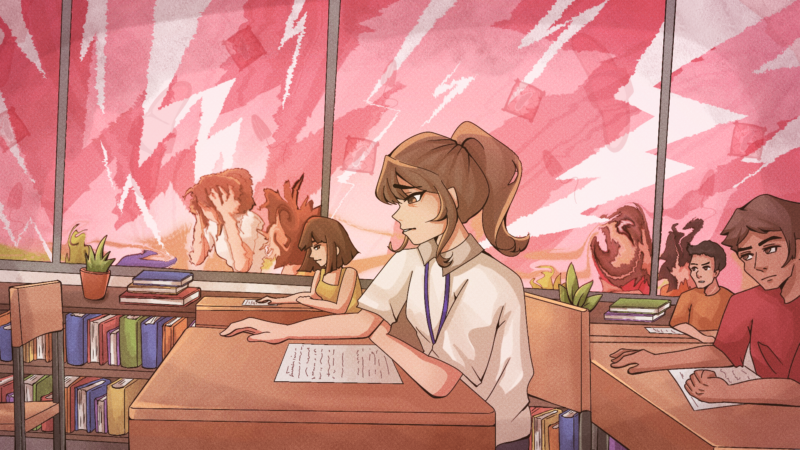
COPY CATS. Photocopying booths are frequented by students around the campus. Photo by Alexandra L. Huang
With the rapid expansion and development of technology, it is interesting to note that the issue of copyright infringement has become a matter for mainstream discourse. From file-sharing in the Internet to the photocopying of books, contemporary society is faced with the difficulty of upholding copyright law—a legal obligation that has all the more become complex since the dawn of the first printing press.
Copyrights in the Philippines are governed by the country’s Intellectual Property Code (IPC). In the Ateneo, the IPC is consciously enforced in the institutional level. For example, signs are displayed in photocopying centers on campus, stating that only 10% of any book is allowed to be reproduced. However, some students of the university perceive such a law to be a burden.
“While I’m aware that the provisions of this rule are for the compensation of the authors who themselves spend tireless effort crafting books, what matters to me in principle is the imparting of knowledge which can only be manifested by the availability of reading materials,” explains junior political science major Xavier Alvaran.
There is truth to Alvaran’s point. One would be mistaken to believe that all Ateneans could afford to buy all the required textbooks for their different subjects. The same holds true for other reading requirements. More often than not, scholars of the Loyola Schools would rely on photocopying subsidies.
The price of a foreign language textbook, for example, can reach up to P1,700. Other students, such as Alvaran, have had to pay 250 pesos for a single class reading. These costs add up to the tuition and other fees that regular students must pay every semester.
Undisputable
It is stated in the IPC that only a single copy of a work can be reproduced, as long as such is done for an individual’s non-profit use. Nevertheless, the law is specific with regard to the number of copies that can be made. “The importation [of original work], consisting of not more than three such copies or likenesses in any one invoice, is not for sale but for the use only of any… state school, college, university, or free public library in the Philippines. Provided, that such copies do not exceed three.”
Since many teachers require all of their students to obtain class readings in the form of complete textbooks, chapters from a book, or articles from academic journals, it is unsound to assume that only three copies of such material are made. Thus, one can argue in this line of thought that there are legal grounds for accusing teachers and students of breaking copyright law.
However, it seems that universities and members of the academe may fall back on the IPC’s Fair Use clause as a basis for such widespread practices. The clause permits the reproduction of a minimal portion of any work without the permission of its author.
“Because it’s in the academe, and the teachers and the students are not profiting from it, I honestly feel that we’re okay,” explains lawyer Elgene Feliciano, a faculty member of the Communication Department who teaches a course on media law and ethics.
The price of knowledge
Most students try to opt out of buying expensive books by choosing to either buy or borrow second-hand books. Some also choose to photocopy textbooks instead. It is in the avoidance of such costs, explains Political Science Department faculty member Rene Raymond Rañeses, that ethics and contextualization come into play. “Part of the reasons why some countries remain underdeveloped is the disparity of access of knowledge because of the price we have to pay for knowledge,” he says.
With the rise of computers, copyright infringement has evolved to go beyond the realm of the photocopying machine. The online age has made the sharing of knowledge much easier compared to the past. Digital versions of materials have become available through the use of e-books and files in the popular PDF format.
A number of professors in the university have utilized readings in electronic formats. Electronic formats consume no paper at all and are much faster to obtain, given the fact that one does not have to wait in line for a copy nor spare any expense.
The difficulty, however, rests in the fact that the digital age has spawned many avenues for copyright violation. A member of the academe could easily post a digital copy of an entire book in an email group, thereby pirating the work to his or her colleagues. The existence of academic file-sharing sites has made adherence to the law even more challenging. The complete works of philosophers like Karl Marx and Michel Foucault, for example, can easily be obtained through the file-sharing website, aaaaarg.org.
Hence, the temptation to illegally download copyrighted material becomes all the more difficult to avoid. Through the ease of access to such pirated material, it is easy for one to subscribe to the absurdity of having to pay for things that can be obtained for free.
Although the IPC safeguards a person’s ownership over his or her original work, the law’s other purpose of protecting a work’s economic value puts into question whether or not knowledge should be commoditized.
Does putting an exorbitant price on a book defeat the purpose of writing the book itself? Yes, books are made available for public use via different libraries, but such institutions do not carry the entire collection of humanity’s written works—nor enough copies of each for every reader. For Feliciano, such a discourse thrusts the issue of copyright to the level of a moral dilemma.
Problems of delineation
Feliciano says that the main point of contention in the copyright debate is the fact that the prices and availability of books drive students and professors to resort to intellectual theft. “Since it’s unavailable and since you are not depriving the author of economic value because it’s not here, you can argue that you are justified in the realm of ethics.”
Rañeses, however, believes that the problem of mere accessibility should no longer even be an issue. He believes that if institutional mechanisms, such as partnerships between academic publishing houses and universities or governmental contracts lowering taxes on educational materials, existed, the playing field of education would be much more level.
“Given the disparity of power between the publishing houses and copyright press and the students, it’s heavily skewed… to the copyright press. In that light, we have to protect the one who is under, [i.e.] the student,” Rañeses explains.
However, to simply reduce the debate on copyright infringement to black and white seems to be impossible. Feliciano and Rañeses agree on the fact that the IPC leads to a subsequent ethical dilemma faced by students and teachers themselves. The difficulties that ensue on the ground when it comes to following copyright law (e.g., on the level of individual classes) could differ widely from the situation on the institutional level.
It is in this gray area, Feliciano says, that it becomes more evident: “The law [is] normative—it tells you how things ought to be, not how things are.”
Overlooking illegality
Though students and professors both acknowledge that copyright law exists, it is an entirely different matter to consider its application in daily university life. With the accessibility of information through the Internet, laws against intellectual theft can easily be overlooked by a society that is used to the instant gratification that comes with having knowledge at the end of one’s fingertips.
The methods of disseminating information have evolved rapidly over time. It is difficult for a modern-day student to imagine what the university students of earlier eras had to go through, during an age where personal computing did not exist. Today, the pages of thousands of books can virtually rest at the palm of one’s hand.
Society’s thinking has thus evolved as well, as shown by the widespread avoidance of spending for copyrighted works, including academic material. As the option of violating copyright law remains very much at the behest of the individual, though, what is thrust in place is room for much ethical debate.








[…] Here’s the link: The Gray Area (by Nadine Y. Ramos) – http://www.theguidon.com/2012/11/the-gray-area/ […]